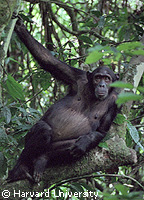Genetic sequencing reveals chimps and humans 'so near, and yet so far'
An international team of scientists has sequenced the genetic code of the chimpanzee, our closest living relative, and compared it with the human genome. The comparison shows that the DNA sequence of the two species is 99 percent identical. The chimpanzee is the first primate genome to be sequenced. Future research will focus on the significance of the differences in an attempt to unveil what makes humans human, and therefore different from other animals. The study was undertaken by an international group called the Chimpanzee Sequencing and Analysis Consortium, made up of 67 scientists at 23 research institutions in the US, Germany, Italy, Israel and Spain, and the results were published in the Nature journal. The work provides a catalogue of the genetic differences that have arisen since humans and chimpanzees diverged from a common ancestor some six million years ago. These data, and all future data from the consortium, are being placed in the public domain, meaning that scientists worldwide can contribute to this work. More than a century ago Darwin and Huxley suggested that humans share recent common ancestors with the African great apes. This prediction was confirmed by modern molecular studies that refined the relationships, showing that the common chimpanzee (Pan troglodytes) and bonobo (Pan paniscus or pygmy chimpanzee) are the closest living evolutionary relatives of humans. Chimpanzees are thus especially suited to teach us about ourselves, not only in terms of their similarities to humans, but also on the differences that translate into our specifically human features, including habitual bipedality, tool use, a greatly enlarged brain and complex language. Important similarities and differences have also been noted for the incidence and severity of several major human diseases. Comparing the human and chimpanzee genomes can help to reveal the molecular basis for these traits as well as the evolutionary forces that have shaped species, including underlying mutational processes and selective constraints. The consortium found that the chimpanzee and human genomes are 'strikingly similar and encode very similar proteins.' The study shows that we differ by only 1.2 percent in terms of the genes that code for the proteins which build and maintain our bodies. This difference rises to about 4 percent when DNA insertions and deletions, or non-coding DNA, are taken into account. The researchers explain that humans and chimpanzees have accumulated more potentially deleterious mutations in their genomes over the course of evolution than have mice, rats and other rodents. While such mutations can cause diseases, eroding the overall fitness of a species, the researchers believe they may have also been at the origin of the adaptability of primates to rapid environmental changes and enabled them to achieve unique evolutionary adaptations. Over the next few years, this comparison will allow us to learn more about the way the human genome has evolved, and gain a better understanding as to why humans get cancers and other diseases that chimpanzees very rarely suffer.
Countries
Germany, Spain, Israel, Italy, United States



